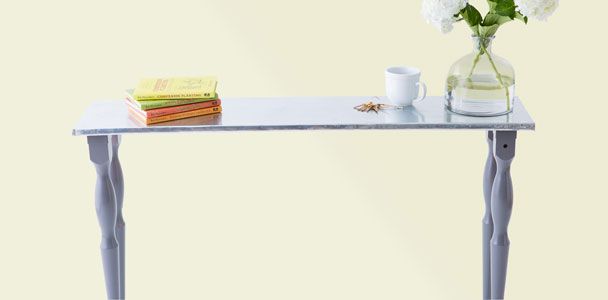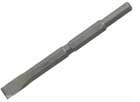Project details
Skill
Cost
Estimated Time
Zinc tabletops have become popular recently due to their unique look and practical benefits. Zinc is naturally antimicrobial, making it good for kitchen surfaces. It’s also soft compared to other metals, which means it’s less likely to chip glassware or dishes placed on it. In this guide, we’ll walk you through building a zinc tabletop, from selecting materials to applying the finishing touches.
Tools
First, gather the following tools.
 Caulk gun
Caulk gun Utility knife
Utility knife Tin snips
Tin snips Quick-grip clamps
Quick-grip clamps Chisel – Flat 12-inch
Chisel – Flat 12-inch Dead blow hammer
Dead blow hammer Soldering gun
Soldering gun Hand file
Hand file
Preparing to Build Your Zinc Tabletop
Once you have the needed equipment, clear a well-ventilated workspace large enough for your table. Gather your zinc sheets, plywood, table base, and tools. For an industrial-style piece, consider using a machine-age cast-iron base, which can often be found for less than $75 at online marketplaces. You could also use premade table legs, such as the Nipen legs from IKEA, which cost about $15 each. Consider turning a wood slab into a table and topping it with zinc to blend natural and industrial styles.
If you’re building a new table, make sure the base is sturdy and level. If you’re working with an existing table, clean the table of debris. Sand down rough spots and fill holes or cracks with wood filler.
Measure your table surface carefully, adding an extra 1-2 inches on all sides to allow for wrapping around the edges. Using your measurements, cut the zinc sheet to size with tin snips. Work slowly and steadily to ensure straight, clean cuts. If you’re new to working with sheet metal, you should practice on a scrap piece first.
How to Build a Zinc Tabletop: Step-by-Step Instructions
Below we provide step-by-step instructions on how to build a zinc tabletop:
Step 1: Attach the Zinc
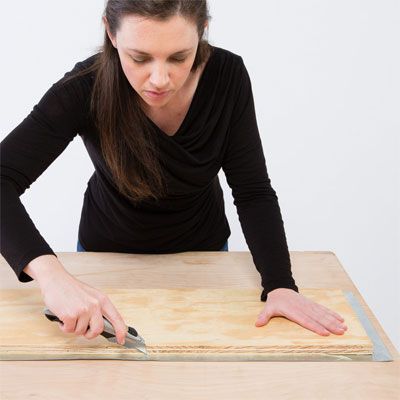
Load the caulk gun with heavy-duty construction adhesive and glue a thin sheet of zinc to the plywood top. Apply a thin, even layer of adhesive to the table surface, working in small sections to prevent drying before you can place the zinc. Be sure to cover the entire surface, especially the edges.
Lay the zinc sheet onto the adhesive-covered table surface, starting at one end and slowly lowering it to avoid air bubbles. Use a clean cloth to smooth it from the center towards the edges, pressing out any air. Flip the piece over so that the metal is on top, and place quick-grip clamps along the edges for a secure hold while it sets. You can also use heavy books or weights across the surface to keep the zinc flat.
Step 2: Cut the Corners

When dry, use a utility knife to score the metal along all four edges for folding. Using tin snips, make a diagonal cut in the zinc at each corner, from the metal’s outermost point to where the corner of the wood starts, creating two triangular flaps. Repeat on all four corners.
Step 3: Bend the Edges
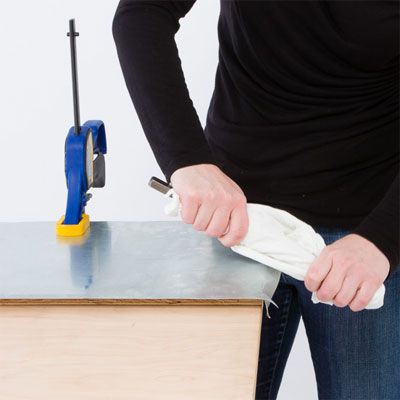
Starting along one side, use a flat 12-inch chisel covered with a clean cloth or rag to bend the zinc around the edge of the wood. Work slowly, moving along one side at a time. Use a dead blow hammer to help smooth the crease and create a tight fold. When the metal is well-creased, glue it to the plywood edge.
Step 4: Wrap the Corners
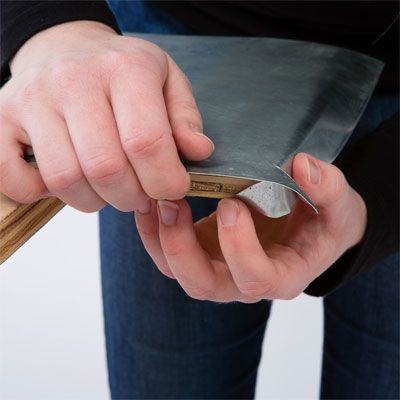
To finish a corner, wrap one triangle of zinc around the plywood edge. Wrap the opposing triangle of zinc on top of it and snip off the top triangular piece of metal. Repeat until all four sides and corners are done.
Step 5: Solder the Corners
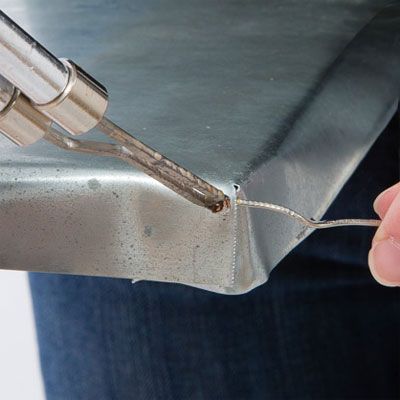
When the soldering gun is hot enough, hold it in your dominant hand and pick up the coil of lead-free solder with your other hand. Place the straight tip of the coil on the rough zinc edge at one corner and touch the tip of the gun to the coil to join the metals. For a smooth and uniform joint, hold for 3 to 4 seconds, then remove the coil before removing the tip of the gun. Repeat on each corner of the table.
Use a metal file to even out the soldered corners and smooth any rough edges along the table. Take care to avoid scratching the zinc. When finished, polish the surface with a soft cloth.
Zinc Tabletop: Adding Decorative Elements
Add copper rivets along the edges or inlay other metals for contrast. Experiment with how to build a three-tiered side table and apply zinc to each level for a multi-dimensional effect.
Zinc develops a patina over time due to the metal oxidizing. If you like the look and want to speed up the process, you can apply a patina or antiquing solution. Clean and dry the surface afterward to prevent damage.
Troubleshooting Common Issues
Here’s how to address some common problems when making a zinc table:
- Bubbles or lifting: You can usually fix bubbles or lifting by injecting a small amount of adhesive under the lifted area with a syringe. Press and weigh the area down until the glue dries.
- Scratches or dents: Buff out minor scratches with fine-grit sandpaper. For deeper scratches or dents, use a metal filler designed for zinc. Apply the filler, let it dry, then sand it smooth to match the surrounding surface.
Caring for Your New Zinc Tabletop
Proper care will keep your zinc tabletop functional and help it develop a beautiful natural finish as it ages. Follow these care tips:
- Wipe the surface with a damp cloth and mild soap for regular cleaning. For tougher stains, mix baking soda and water.
- Avoid using harsh chemicals or abrasive cleaners.
- Always dry the surface thoroughly to prevent water spots.
